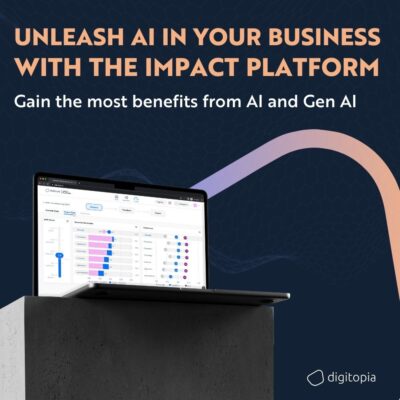
The narrative is everywhere:
AI will revolutionize your industry.
AI will automate your workflows.
AI will drive innovation, efficiency, and profitability.
But behind closed doors, many executives are quietly asking:
“If AI is so powerful, why aren’t we seeing the results?”
The answer is simple, but often overlooked:
Because AI doesn’t work on broken foundations.
Before AI can drive value, it needs clean data, integrated systems, cloud infrastructure, governance, business engagement, and operational readiness.
In other words—you need digital maturity first.
This is the story of a European manufacturing firm that learned this the hard way—then did it right.
Case Study: The Allure—and the Letdown—of AI Pilots
Two years ago, the company’s leadership greenlit several AI initiatives:
- Visual inspection using computer vision for quality assurance
- Predictive maintenance models on key production lines
- Demand forecasting using machine learning
Each initiative had executive backing and enthusiastic teams. Vendors were engaged. POCs were launched.
The early results were promising—but none of the pilots scaled.
Why?
Because:
- Image data from the shop floor was inconsistent and siloed
- Sensor data lacked real-time access and was poorly labeled
- ERP integration was non-existent, so outputs couldn’t trigger workflows
- Maintenance teams didn’t trust the predictions
- Forecasting models failed when exposed to real-world variability
It wasn’t an AI problem.
It was a digital infrastructure problem.
Their systems were fragmented.
Their data was unreliable.
Their teams were misaligned.
Their culture wasn’t ready.
AI was exposing—not solving—their digital immaturity.
The Wake-Up Call
After months of firefighting and vendor switching, the company’s COO called it:
“We don’t have an AI problem—we have a foundation problem.”
That’s when we were brought in to run a Digital Maturity Index (DMI) assessment across the entire value chain.
What we uncovered in a one-day moderated session shocked many leaders:
- Digital maturity score: 2.4 out of 5
- Weaknesses in data governance, IT integration, business-IT collaboration, and change readiness
- 23 active digital projects with no shared prioritization or architectural alignment
- Factory-level systems not standardized, creating inconsistent data formats
- No central analytics platform or MLOps capability
The executive summary was clear:
“You’re trying to fly AI jets from a dirt runway.”
Laying the Runway for AI Takeoff
Instead of abandoning AI, the leadership team made a bold move:
pause, fix, then scale.
They used the DMI results and Strategy Cockpit to identify and prioritize foundational initiatives:
Data Foundation Program
Standardize data definitions, deploy IoT gateways at plants, implement data lake architecture, and launch a data catalog.
ERP & MES Integration Layer
Enable real-time, bidirectional data exchange between ERP, MES, and edge devices.
AI Governance and MLOps
Define AI lifecycle ownership, model versioning, performance monitoring, and business review cycles.
Business-IT Collaboration Hubs
Cross-functional squads embedded in plants and business units, jointly owning use cases.
Cultural Readiness Program
Training, communication, and change enablement for plant managers, engineers, and planners.
This wasn’t glamorous—but it was necessary.
And it paid off.
Results Within 18 Months
With the foundation in place, they relaunched their AI pilots—this time, grounded in mature digital infrastructure.
The business impact was dramatic:
✔️ Visual inspection
Deployed across three plants. Reduced false positives by 78%, increased detection accuracy to 96%, saving €2.1M annually in scrap and rework costs.
✔️ Predictive maintenance
Expanded to seven critical production lines. Cut unplanned downtime by 19%, saving €1.8M in lost production.
✔️ Demand forecasting
Integrated with ERP planning module. Improved forecast accuracy by 11%, reducing inventory holding costs by €2.2M.
Total value delivered: €6.1M in 12 months of post-foundation deployment.
The AI use cases hadn’t changed—but the readiness had.
And that made all the difference.
AI Pilots Keep Failing?
Don’t blame the model—check the foundation. Our AI Maturity solution helps you assess readiness across data, governance, integration, and business alignment—so your pilots can scale and succeed.
Why Digital Maturity Is the Prerequisite
Here’s what executives must understand:
1. AI needs clean, accessible, real-time data
If your data is stuck in spreadsheets, scattered across legacy systems, or missing key attributes, your models will fail. Garbage in, garbage out.
2. AI needs connected systems
Even the smartest model is useless if its output can’t trigger action. Integration with ERP, MES, CRM, and other systems is essential.
3. AI needs collaboration between tech and business
The best models solve real problems. That only happens when domain experts and data scientists co-own the use case.
4. AI needs governance and lifecycle management
Without model validation, explainability, and continuous monitoring, AI becomes a black box—and business will reject it.
5. AI needs cultural readiness
If frontline staff don’t understand or trust the AI, it will never be adopted.
All of these are part of digital maturity.
And without them, AI is just a lab experiment.
Measuring Maturity as a Strategic Tool
This company didn’t succeed with AI because they bought better tools.
They succeeded because they measured their maturity, identified the gaps, and invested in the right foundations.
They used the DMI to align stakeholders.
They tracked progress with repeat assessments every six months.
They visualized priorities and impact using the Strategy Cockpit.
AI didn’t lead their transformation—maturity did.
And that created real business value.
Maturity as Momentum
Today, the company treats AI as a portfolio—tied to business value.
They have a quarterly AI Council.
They use maturity metrics as part of leadership KPIs.
And they continue to expand AI across procurement, energy management, and quality analytics.
But they never confuse tools with transformation.
They know the magic only works when the runway is solid.
What’s Measured Gets Done
Let’s be clear: AI is not a shortcut.
It is a multiplier.
It multiplies what your organization is already good at—or already struggling with.
If your foundations are weak, AI will highlight your problems.
If your foundations are strong, AI will accelerate your progress.
That’s why digital maturity isn’t a sideshow.
It’s the main event.
Before you chase the future—strengthen your infrastructure.
Before you scale AI—measure your maturity.
Before you seek magic—build the runway.
And always remember: what’s measured gets done.




